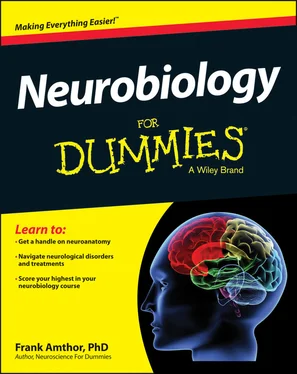Many invertebrates such as worms and insects have less than a few thousand neurons that are more or less the same from animal to animal. Individual neurons in specific places are even numbered and named in some species. This vastly simplifies the problem of working out a complete neural circuit, including which neurotransmitters are used by which neurons to activate other neurons, and how all the electrical activity is integrated.
 Recent progress has been made in making model systems from mammals, using either brain slices or neural tissue cultures that can be mounted on a microscope and recorded and stimulated under well-controlled conditions.
Recent progress has been made in making model systems from mammals, using either brain slices or neural tissue cultures that can be mounted on a microscope and recorded and stimulated under well-controlled conditions.
Many scientists feel that we only understand a system when we can simulate it. This involves creating an artificial nervous system that simulates some properties of real ones. In robotics, behavior is simulated. A robot may perform some task, like welding in a car factory, that is otherwise done by intelligent humans. The electronic controllers of such robots can involve the use of neuron-like elements called artificial neural nets (ANNs) that emulate biological control systems. However, most controllers are written in standard computer languages using mathematical algorithms that may function quite differently from biological organizations.
Bionics is the field of applying biological principles of operation to man-made devices. An airplane is a bionic derivative of bird flight, which, however, differs in using engines for thrust rather than flapping wings. A recent use of bionics in computation involves devices called memristors that are integrated circuit devices that act like modifiable synapses between neurons. At this point, it’s unclear whether memristors devices will have advantages for computing compared to traditional electronic computation done with transistors. They may, however, become a useful tool for simulating complex nervous systems to understand them.
Organizing the Nervous System
The study of the nervous system intrinsically involves many fields. Neurobiology, our focus here, depends on physiology, anatomy, biochemistry, molecular biology, cognitive and behavioral psychology, and artificial intelligence. The basic goals of neurobiology are to describe how the nervous system operates in terms of what the system does, how it’s built, and how it works. We try to do these things by considering first various subsystems of the brain and nervous system, and then looking carefully at function in the neural circuitry within those subsystems.
Movement basics: Muscles and motor systems
Chapter 5deals with the main purpose of the nervous system, the production of movement. Generally, animals move and have nervous systems to control movement, whereas plants don’t. Voluntary movement, controlled by the central nervous system, involves the contraction of striated muscle triggered by the receipt of acetylcholine, a neurotransmitter released by motor neurons.
Individual muscles are made of thousands of muscle cells innervated by several different types of motor neurons. The contraction of the muscle is produced by the coordinated activity of all these motor neurons that fire in a specified sequence and rate depending on the type of movement programmed, its speed, duration, and variation in load the limb experiences as it moves. Differences or errors between the central commands and actual limb position and acceleration are reported by sensory neurons in the muscles, tendons, and joints that relay this information to the spinal cord in a feedback loop that adjusts the motor neuron output to match the upper-level command goal.
 The entire frontal lobe of the brain exists primarily to program and organize goal-directed movement. An abstract goal, such as hitting a tennis ball back into your opponent’s court, is translated into a sequence of leg, torso, and arm movements to accomplish this goal. These sequences are programmed into the motor cortex following practice. This practice involves learning sequence timing with the help of the cerebellum. The cerebellum is involved in learning and setting up predictive, feed-forward control for appropriate timing of sequences that transition more rapidly than feedback spinal sensory control could correct.
The entire frontal lobe of the brain exists primarily to program and organize goal-directed movement. An abstract goal, such as hitting a tennis ball back into your opponent’s court, is translated into a sequence of leg, torso, and arm movements to accomplish this goal. These sequences are programmed into the motor cortex following practice. This practice involves learning sequence timing with the help of the cerebellum. The cerebellum is involved in learning and setting up predictive, feed-forward control for appropriate timing of sequences that transition more rapidly than feedback spinal sensory control could correct.
The spinal cord and autonomic nervous system
The spinal cord is like a subcontractor of the brain that executes the brain’s instructions and reports on their progress. The spinal cord is part of the central nervous system, contiguous with it as it merges with the medulla of the brainstem. Chapter 6discusses its basic organization.
 The spinal cord is the transition below the neck between the central and peripheral nervous systems. The peripheral nervous system includes the motor neuron axons that originate within the spinal cord gray area and project from the cord to synapse on muscle cells. Sensory neurons — whose cell bodies are located in dorsal root ganglia just outside the spinal cord — send one axon collateral to the periphery to elaborate into a sensory receptor, while the other collateral makes conventional synapses in the spinal cord gray area for both local circuit spinal feedback control and for relaying sensory information to the brain.
The spinal cord is the transition below the neck between the central and peripheral nervous systems. The peripheral nervous system includes the motor neuron axons that originate within the spinal cord gray area and project from the cord to synapse on muscle cells. Sensory neurons — whose cell bodies are located in dorsal root ganglia just outside the spinal cord — send one axon collateral to the periphery to elaborate into a sensory receptor, while the other collateral makes conventional synapses in the spinal cord gray area for both local circuit spinal feedback control and for relaying sensory information to the brain.
The autonomic and enteric nervous systems are involved in body homeostasis (keeping the body’s major systems stable and functioning) through controlling glandular secretions, heart rate, respiration, and smooth muscle function. The autonomic nervous system has major subdivisions into sympathetic and parasympathetic branches that tend to oppose each other’s actions. The sympathetic system prepares us for action in the fight-or-flight mode, while the parasympathetic system organizes resources for digestion, and the maintenance and conservation of energy.
The brainstem, limbic system, hypothalamus, and reticular formation
When we look at a human brain from above, almost all that we see is neocortex. Students beginning to study the brain often mistakenly think that the neocortex is the real, important part of the brain that has largely superseded phylogenetically older structures that are now almost vestigial and unnecessary (like the appendix).
This is an understandable mistake. However, non-mammalian vertebrates like lizards, frogs, and crocodiles execute complex behavior without any neocortex. Some mammals have very little neocortex as well. The relationship between the neocortex and “lower” brain areas is as much their servant as master, an idea Chapter 7explores.
The brainstem is not only a transition region between the spinal cord and higher brain centers, but an essential integration and control center by itself. The brainstem includes the medulla at the intersection with the spinal cord, the pons just above the medulla, and the midbrain above that. The cerebellum hangs off the back of the brain behind the pons. The brainstem nuclei convey information between the senses and the spinal cord and higher brain centers. Brainstem nuclei also control essential aspects of homeostasis such as the regulation of heart rate, respiration, and temperature.
 Limbic system is an archaic term for a diverse set of subcortical brain areas that are thought to control instinctive behaviors. Areas included in the limbic system’s original formation include the hippocampus, amygdala, and cingulate cortex. Chapter 7discusses how these areas interact with neocortex and other parts of the brain, not as a modular system, but as a set of crucial brain areas each with distinct functions.
Limbic system is an archaic term for a diverse set of subcortical brain areas that are thought to control instinctive behaviors. Areas included in the limbic system’s original formation include the hippocampus, amygdala, and cingulate cortex. Chapter 7discusses how these areas interact with neocortex and other parts of the brain, not as a modular system, but as a set of crucial brain areas each with distinct functions.
Читать дальше

 Recent progress has been made in making model systems from mammals, using either brain slices or neural tissue cultures that can be mounted on a microscope and recorded and stimulated under well-controlled conditions.
Recent progress has been made in making model systems from mammals, using either brain slices or neural tissue cultures that can be mounted on a microscope and recorded and stimulated under well-controlled conditions. The entire frontal lobe of the brain exists primarily to program and organize goal-directed movement. An abstract goal, such as hitting a tennis ball back into your opponent’s court, is translated into a sequence of leg, torso, and arm movements to accomplish this goal. These sequences are programmed into the motor cortex following practice. This practice involves learning sequence timing with the help of the cerebellum. The cerebellum is involved in learning and setting up predictive, feed-forward control for appropriate timing of sequences that transition more rapidly than feedback spinal sensory control could correct.
The entire frontal lobe of the brain exists primarily to program and organize goal-directed movement. An abstract goal, such as hitting a tennis ball back into your opponent’s court, is translated into a sequence of leg, torso, and arm movements to accomplish this goal. These sequences are programmed into the motor cortex following practice. This practice involves learning sequence timing with the help of the cerebellum. The cerebellum is involved in learning and setting up predictive, feed-forward control for appropriate timing of sequences that transition more rapidly than feedback spinal sensory control could correct.










